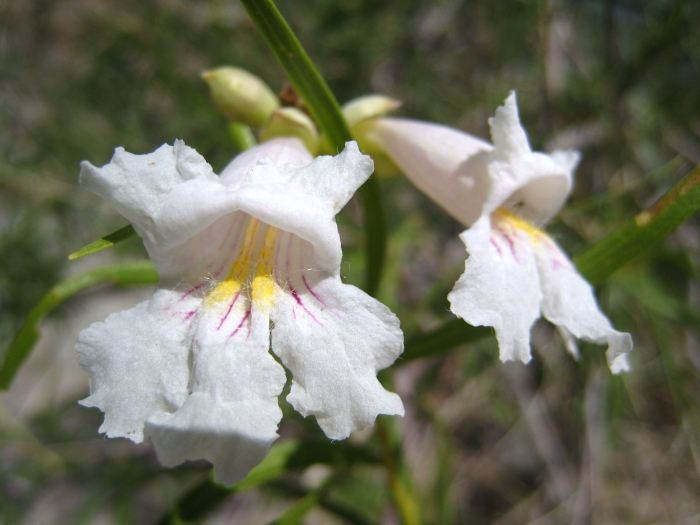Desert Willow
(Chilopsis linearis subsp. arcuata)
Desert Willow (Chilopsis linearis subsp. arcuata)
/
/

Ciar
Public domain
Image By:
Ciar
Recorded By:
Copyright:
Public domain
Copyright Notice:
Photo by: Ciar | License Type: Public domain | License URL: https://creativecommons.org/public-domain/ | Uploader: Ciar | Publisher: Wikimedia Commons | Title: White_trumpet_flower_Anza-Borrego.jpg | Notes: |



























































Estimated Native Range
Summary
Chilopsis linearis subsp. arcuata, commonly known as Desert Willow, is a deciduous shrub or small tree native to arid environments such as desert washes, dry creek beds, and canyons in the Southwestern USA and Northwestern Mexico. It typically grows to a height and width of 5-25 feet (1.5-7.6 meters), with a loose, open canopy and a picturesque, twisting form. The narrow, willow-like leaves contribute to its common name, though it is not a true willow. From late spring to early fall, it produces showy, trumpet-shaped flowers with colors ranging from lavender to pink, often with yellow and purple markings inside. The bark is smooth and brown, becoming furrowed with age.
Desert Willow is valued for its drought tolerance and ability to thrive in hot, dry climates, making it an excellent choice for xeriscaping and water-wise gardens. It is also used for erosion control and as a wildlife attractant, providing nectar for hummingbirds and other pollinators. In cultivation, it requires full sun, minimal water once established, and well-drained soils. While it is relatively low-maintenance, it can be prone to breakage in high winds due to its open canopy. Desert Willow is not known for aggressive roots or significant disease problems, but it can be affected by pests such as borers if stressed.CC BY-SA 4.0
Desert Willow is valued for its drought tolerance and ability to thrive in hot, dry climates, making it an excellent choice for xeriscaping and water-wise gardens. It is also used for erosion control and as a wildlife attractant, providing nectar for hummingbirds and other pollinators. In cultivation, it requires full sun, minimal water once established, and well-drained soils. While it is relatively low-maintenance, it can be prone to breakage in high winds due to its open canopy. Desert Willow is not known for aggressive roots or significant disease problems, but it can be affected by pests such as borers if stressed.CC BY-SA 4.0
Plant Description
- Plant Type: Tree, Shrub
- Height: 5-25 feet
- Width: 5-25 feet
- Growth Rate: Moderate
- Flower Color: Red, Pink, Purple
- Flowering Season: Spring, Summer
- Leaf Retention: Deciduous
Growth Requirements
- Sun: Full Sun
- Water: Low
- Drainage: Fast
Common Uses
Bee Garden, Bird Garden, Butterfly Garden, Drought Tolerant, Fragrant, Hummingbird Garden, Low Maintenance, Showy Flowers
Natural Habitat
Desert washes, dry creek beds, and canyons in the Southwestern USA and Northwestern Mexico
Other Names
Common Names:
Scientific Names: , Chilopsis linearis subsp. arcuata, Chilopsis linearis var. arcuata,
GBIF Accepted Name: Chilopsis linearis subsp. arcuata (Fosberg) Henrickson